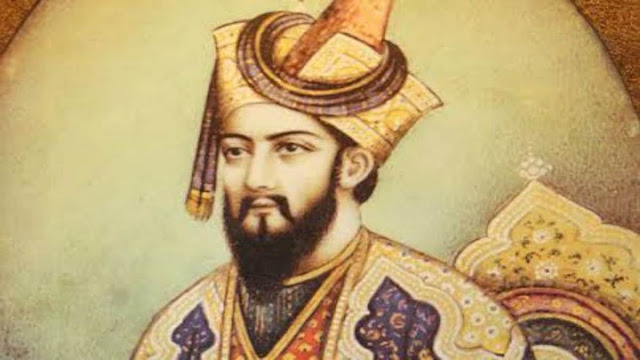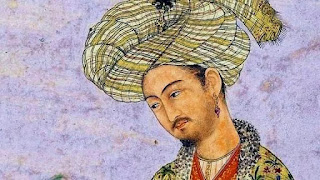Babur, or Zahir-Ud-Din Muhammad Babur, to give him his full name, was the founder of the Mughal dynasty. He was a truly remarkable man. Babur was born on February 14, 1483.
His mother Qutluq Nigar Khanum, was a descendent of the greatest of the Mongol warriors, Genghis Khan, while his father Umar Shaikh Mirza carried the blood of the legendary Timur who conquered and ruled the ancient city of Samarqand.
At the age of twelve, Babur ascended the throne of the Central Asian kingdom of Ferghana. His greatest ambition was to rule Samarqand. He fought many battles in the pursuit of this goal, winning and losing his kingdom many times in the process. In 1504, he ventured into what is now Afghanistan and conquered Kabul.
Babur invaded India five times, crossing the River Indus each time. The fifth expedition resulted in his encounter with Ibrahim Lodi. Strategy of Babur won the war, and Ibrahim Lodi died fighting. This marked the start of the Mughal rule in India.
Babur was a highly cultured and remarkable emperor. He was devoted to art and literature and was a fine poet himself. He respected all religions and did not destroy the lands that he invaded and won, like his ancestors. He was not only a brilliant general but also a great swordsman.
Babur was a man of extraordinary energy and strength. He had been known to take up a man under each arm, and run with them around the battlements of a fortress!
Why do we have so many details about the Mughal empire?
Even though the Mughals ruled centuries ago, we know a lot about then because many of the emperors kept detailed memoirs which they dictated to their trusted scribes. These memoirs were beautifully illustrated too, and painters sometimes accompanied an emperor into the battlefield so that they could accurately depict the scenes on canvas. For example; the book ‘Akbar Nama’ is an authentic record of Akbar's reign and times. It was written by Abul Fazl, the court historian. Of course, sometimes the court historians and scribes exaggerated the emperor’s virtues and ignored his faults for all, they wanted to lease their masters!
There were many European visitors to the Mughal court too, and they wrote about the magnificent wealth and immense power wielded by the Mughal emperors. As a result, we are today able to know a lot about life in those days, the daily routines of the emperors, their likes and dislikes, as well as their important battles and the landmarks in their reign.
What is the Babur Nama?
The Babur Nama, the autobiography of India’s first Mughal emperor, Zahir ud Din Muhammad Babur is one of the true marvels of the medieval world. In fact, Babur’s memoirs are the first true autobiography in Islamic literature.Between the moment when he gained his first kingdom at the age of twelve, and his death thirty-six years later, there seems scarcely to have been a quiet day in Babur's life. In the Babur Nama, Babur tells his story in great detail, whether it is describing how he spent a day with friends or recounting the battles he waged. The Babur Nama is widely translated and is part of textbooks in no less than twenty-five countries mostly in Central, Western, and Southern Asia. The book gives us an insight into the personality of a brilliant ruler and a highly cultivated, courageous, and humane man of action.
Why did Babur lose Ferghana?
Babur became king when he was only twelve years old! However, he had to face many enemies who plotted against him. At that time, he was also fascinated by Samarqand, which was the capital of his great ancestor Timur's kingdom and he dreamt of sitting on the throne of Samarqand too. After one failed attempt, he did succeed in his dream, but he could not rejoice for long, because he fell very ill soon after he captured Samarqand.
Babur’s ministers in Ferghana declared that he was dead, and put his younger brother on the throne. Babur tried to regain Ferghana, once he recovered, but failed. In the meantime, while he was concentrating on getting Ferghana back, his cousin Ali took over the throne of Samarqand! So, Babur lost both Ferghana Samarqand and had no territory left to rule except the small and hilly district of Khujand
Babur however, did not give up. He was able to recover both Samarqand and Ferghana, though he lost Samarqand again later. Babur went on to conquer Kabul and later India, and to establish the mighty Mughal empire. His is an inspiring tale of how courage and determination can turn failures into success stories
Why did Babur want to conquer India?
Babur, a ruler of Samarqand, a small kingdom in Turkestan, rose to become the Emperor of India in the 16th century. His fascination with India began when he heard of the invasion of India by his ancestor Timur. He believed himself to be the rightful heir to the throne of Timur and the lands that his ancestor had conquered in India. So, he made several preliminary raids into India before he finally defeated the Afghan Sultan of Delhi, Ibrahim Lodi, and established the Mughal dynasty that was to rule India for the next two centuries.
Why was Babur able to win the battle of Panipat?
On April 1526, Babur reached Panipat as invited by Dawlat Khan. It was a barren wasteland, with just a few thorny bushes dotting the dry landscape. Rumors abounded that the Sultan was coming with an army of 100,000 and 1000 was elephants, but Babur was confident of victory, though he had an army of just 12,000. However, he had many cannons and gun powder at his command.
The battle started at six in the morning. Sultan Ibrahim Lodi advanced rapidly. Babur’s cannons opened fire, and the noise of cannons at close range was even more terrified and ran wildly out of control. By clever tactics, Babur forced and the Sultan’s army into a bottleneck and pounded them with his guns. The battle ended in about three hours with the death of Ibrahim Lodi who was at the forefront.
The loses to Babur’s army were heavy, over 4000 of his
troops were killed or wounded. When the Sultan’s army fled, they left 20,000
dead. However, had Sultan Ibrahim survived another hour of fighting he would
have won as Babur had no reserves and his troops were rapidly tiring? But the
might army of Delhi was vanished, and perhaps the most important reason for
Babur’s victory was his powerful artillery, the light guns, and muskets that
were new weapons from Turkey
Why did Babur have to continue fighting even after defeating Ibrahim Lodi?
As a result of the Battle of Panipat in 1526, Babur became the ruler of Delhi and Agra. He now had to fight against two other enemies, the Afghan nobles of Bihar and Bengal, and Rajputs under Rana Sangaof Mewar
Rana Sanga was a brave warrior. Some Muslim supporters of the Lodi dynasty had joined him. He marched with an army of 120 chiefs. 80,000 horses and 500 war elephants and was supported by the rulers of Ajmer, Gwalior, Amber and Marwar. Babur’s army was comparatively small, but his men fought bravely, and he used his artillery well. In fact, Babur used the same tactics that he used in the battle of Panipat, and thus defeated the Rajputs.
Babur then turned to the Afghan chiefs who had joined together against him, led by Ibrahim Lodi’s brother Mahmud Lodi. He met the Afghans on the banks of River Gogra. and defeated the Afghans on May 6, 1529. He thus became the master of the whole of Northern India, and Agra became the capital of his empire.
Why did Babur create gardens wherever he went?
Babur was a lover of nature and a lover of beauty too. So, he created many magnificent gardens wherever he went. They were about ten in all, and each garden was a masterpiece in itself. They were beautifully laid out waterway, and pathways, interspersed with colourful flowerbed where roses, narcissus and other exotic plant bloomed. He even planted banana and sugarcane plants from India in some of his gardens, because he delighted in the colours of the ripe fruits.
Babur’s gardens served a practical purpose as well. Since he was constantly on the move, he preferred to pitch his tent amidst greenery and beauty rather than in a dry and barren place. In India, where he encountered a shortage of water, he dug deep wells and used water wheels so that there would be exquisite gardens every corner of his kingdom.
Why is the Babur considered one of the greatest of emperors?
Babur is considered a truly great emperor for many reasons. To begin with, he was a good human being, a dutiful son, a caring husband, loyal friend and compassionate ruler. He was a man of faith, yet he was tolerant of all religions. He was strong and brave, and a great scholar and lover of the fine arts.
From the cradle to the grave, Babur had to fight for the safety of his life and throne. He was an admirable horseman, a fine shot, a good swordsman and mighty hunter. He also had a strong sense of history, and his place in it is secure for all time, as the founder of one of the greatest dynasties of the medieval world. No one who has read his remarkable autobiography, and understood how he carved out an empire out of nothing, can doubt his greatness and his military shrewdness.

